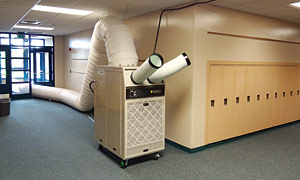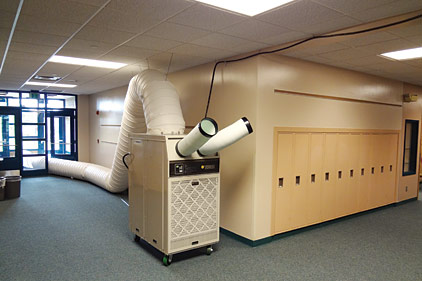
|
| Portable heating and cooling can help alleviate comfort problems when a building’s system is offline. |
According to Rob Shortt, vice president, Cold Air Products, Norfolk, Va., the portable heating and cooling sector is widely driven by inclement weather and the impending need for comfort.
“When you see the storms, especially in the summertime, you can expect a lot of inquiries coming your way,” Shortt said. “A number of the calls, though, aren’t to remedy a system that has completely shut down. A lot of them are for emergency backup or supplemental needs. They are in a state of need, or are preparing for a specific need, and need something now.”
Seasonal Solutions
The summer is what Tina Behnke, customer experience officer, AirPac Inc., calls the crisis cooling season.
“We definitely see spikes in what we call our crisis cooling season, probably from about May through August,” she said. “It’s not just that there’s more of a need, but it’s critical. All of a sudden it’s really hot outside and they might have a critical piece of equipment that’s down, like an air conditioner in a server room, or data-center air conditioner, or an air conditioner in a retail application. We definitely see spikes in the summer months.”
As computers become more prevalent, and server rooms continue to proliferate, it has changed the industry and how it operates, to a certain extent. “Over the past four or five years, our seasonal needs have really leveled out,” said Behnke. “The desire for portable cooling is occurring all year-round.”
That has led to increased demand for portable cooling for all 12 months of the year, although the winter months, obviously, have less cooling demand than the summer months.
“We rent them year-round, but the selling season starts in the spring,” said Scott Brainard, vice president, product development, Temp-Air Inc., Burnsville, Minn., “Around April it starts kicking in and by June it’s in full swing. Those are the bread-and-butter months. Those months are key for us, in terms of people renting or purchasing units for that matter.”
For Charley Rowland, president, Air Systems Sales and Rentals, Lake Oswego, Ore., he said demand for his business branches out beyond process cooling.
“We see people in film more and more, and we do an enormous number of outdoor activities, having to do with sales promotions from big companies with giant tents to small weddings,” Rowland said.
While portable cooling has trended more toward cooling processes rather than people, portable heating, said Rowland, is the direct opposite. “Most equipment can tolerate the cold better than the heat,” Shortt said. “When you’re providing heat, it’s almost exclusively for people.”
Severe Impact
Severe weather is a major trigger for portable air conditioning suppliers and installers.
“You always have to be ready to respond,” Shortt said. “That’s just part of it. That’s part of the routine. Everything’s an emergency.”
Behnke said severe weather throws a monkey wrench into everything, and they do their best to work with companies beforehand to line things up during the first rush, which comes in the days leading up to a strong weather pattern, such as a hurricane.
“Once it’s passed the initial crisis period, we see another rush,” Behnke said.
“In the days leading up to it, there’s a rush to get equipment in place so that it’s there, and then about two to three weeks after, once they’ve sorted through things and are about to set up some temporary work environments, for either insurance processing or claims processing, then we see another rush to get equipment in a place so people can conduct their business in temporary fashion until they get their permanent equipment in place.”
Dane Taival, vice president of building services, Trane North America, said prior to an anticipated severe weather event there is typically a lot of planning with customers. “Common questions that arise include the availability of systems, pricing of solutions, and the response time needed to provide them. Given the expected size and duration of the severe weather event, Trane may move additional fleet capacity to the impacted area in order to be prepared for quick responses,” he said.
“Trane took this approach last year for Super Storm Sandy, for example. Although some clients with critical systems/environments such as hospitals or data centers do rent prior to the event, most simply want to understand where the resources are in case they are needed after the severe weather. In the aftermath of a disaster, it is difficult for building operators to look beyond the immediate priority of getting the facility up and running, reoccupying the building, and returning things to business as usual.”
“However, Sandy is a good reminder of the value of having an effective disaster recovery and business resumption plan that includes power and HVAC. Such a plan can help an organization reduce financial risk, protect the health and safety of building occupants, and provide peace of mind for the organization and its stakeholders.”
Brainard said during Hurricane Katrina in 2005, every piece of cooling equipment they had went down to New Orleans. But severe weather, and weather in general, are going to continue to drive rentals and sales of portable heating and cooling, especially in the summer months.
“We always receive preemptive calls to see if we have any inventory, anything ready to go,” Brainard said. “We do get those calls. It’s a little speculation for everybody at that point, more so for the major disasters that are about to happen or are happening, versus some of the smaller tornado-type stuff, those are more reactionary.”
Publication date: 7/1/2013
Want more HVAC industry news and information? Join The NEWS on Facebook, Twitter, and LinkedIn today!



Report Abusive Comment